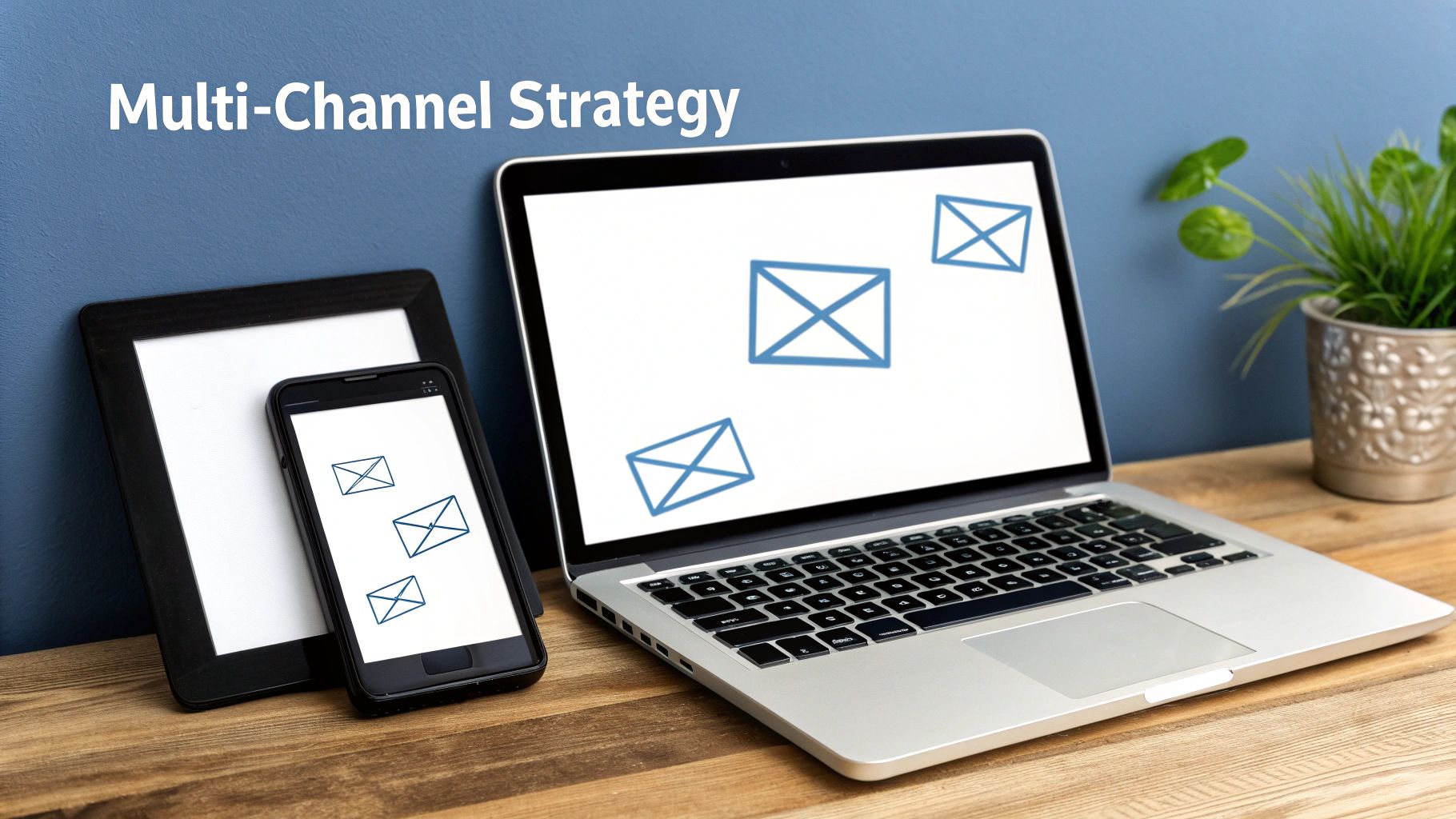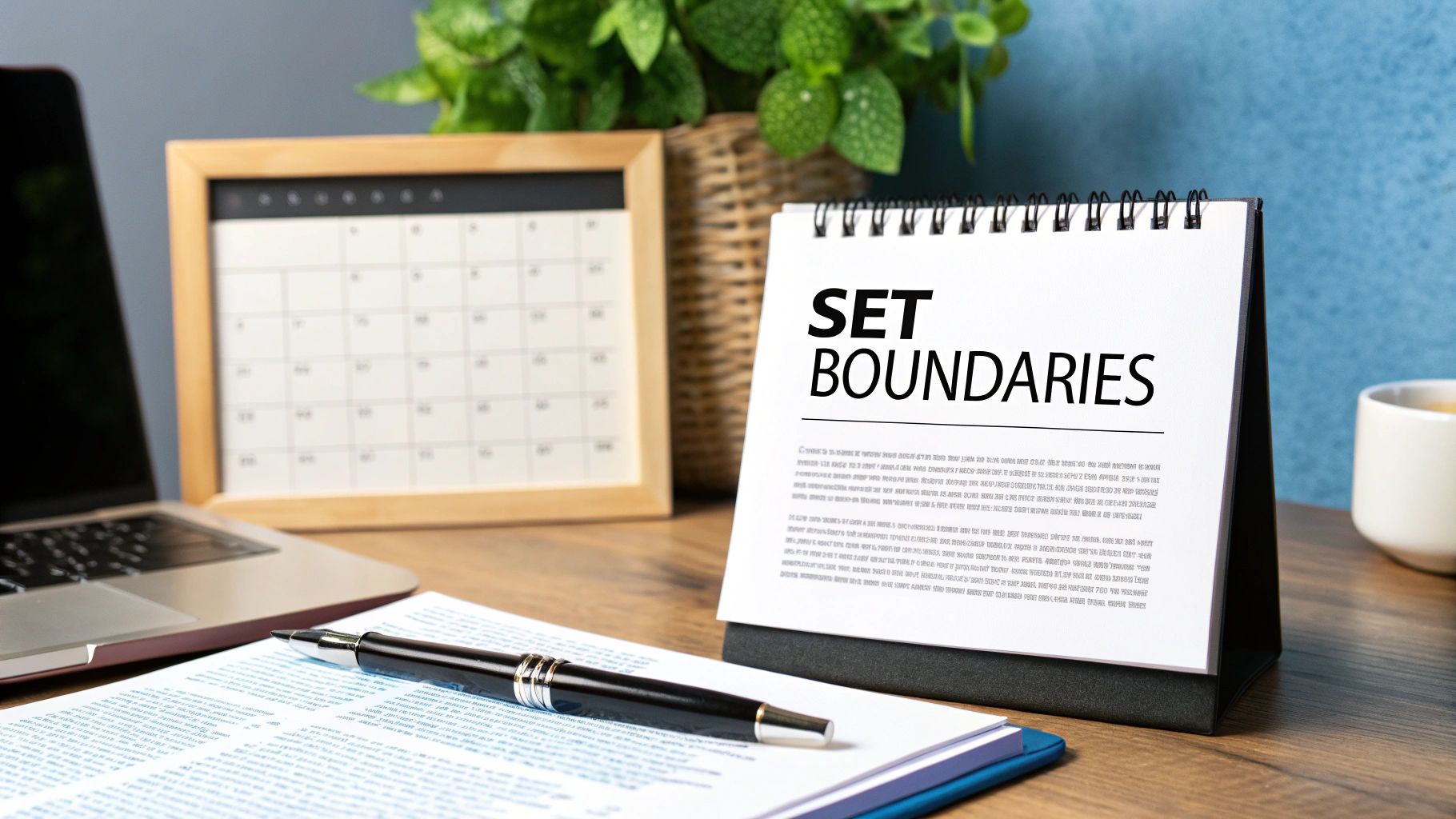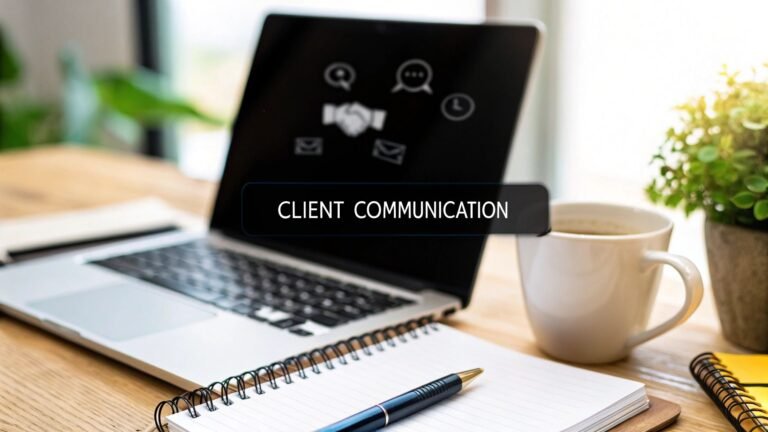In a world of competing products and services, the quality of your client relationships often becomes the ultimate differentiator. Effective communication isn't just about sending updates; it's the foundation of trust, the key to managing expectations, and the tool that transforms transactional relationships into strategic partnerships. Get it wrong, and you risk derailing projects, eroding confidence, and losing valuable clients. Get it right, and you create loyal advocates for your brand.
This guide moves beyond generic advice to provide a comprehensive list of client communication best practices that are specific, actionable, and proven to work. We will break down eight critical strategies, from active listening and setting clear boundaries to implementing a multi-channel communication plan that meets clients where they are. These techniques are designed to build stronger, more profitable, and lasting professional relationships.
These practices also directly support broader relationship-building efforts. To truly highlight why communication is your most valuable asset, consider these additional Top Customer Service Best Practices that complement the strategies discussed here. By mastering these skills, your team can ensure every client interaction reinforces their decision to partner with you, turning simple satisfaction into long-term loyalty.
1. Active Listening and Empathetic Response
Effective client communication begins not with what you say, but with how you listen. Active listening is the practice of fully concentrating on a client’s message, understanding their perspective, and responding thoughtfully. It's the difference between merely hearing words and truly comprehending the underlying needs, concerns, and emotions behind them. This foundational skill builds trust and makes clients feel genuinely valued.

Pioneered by figures like Stephen Covey, this approach is a cornerstone of exceptional service. For example, Salesforce implemented active listening training for its customer success teams, which led to a remarkable 25% improvement in client retention. Similarly, Zappos empowers its representatives to spend unlimited time listening to customers, a strategy that has built legendary loyalty.
How to Implement Active Listening
To integrate this into your daily interactions, focus on creating an environment of undivided attention. This is a key client communication best practice that signals respect and focus.
- Eliminate Distractions: During client calls, put away your phone and close any unnecessary browser tabs.
- Confirm Understanding: Use reflective phrases like, "What I'm hearing is…" or "It sounds like the main challenge is…" to verify you've understood correctly.
- Embrace Silence: Allow a few seconds of silence after the client speaks. This pause prevents interruptions and gives you time to formulate a thoughtful response.
- Practice the 80/20 Rule: Aim to listen 80% of the time and speak only 20%. This ensures the conversation remains client-focused.
"Most people do not listen with the intent to understand; they listen with the intent to reply." – Stephen Covey
Following up a conversation with an email that summarizes the key points discussed is another powerful way to demonstrate that you were paying close attention. It confirms alignment and creates a clear record for both parties, solidifying the client's confidence in your partnership.
2. Proactive and Transparent Communication
Anticipating client needs before they arise is the hallmark of a truly strategic partnership. Proactive communication involves reaching out with updates, insights, or potential issues before the client has to ask. Paired with transparency, which means being honest about progress and setbacks, this approach builds immense credibility and effectively manages expectations, preventing small issues from escalating into major problems.

This philosophy has been championed by companies like Buffer, known for its "radical transparency," and the founders of Basecamp. For instance, Basecamp's automated weekly project digests keep clients informed without manual effort, reportedly cutting down status-check emails by over 60%. Similarly, construction giant Turner Construction implemented real-time project dashboards for clients, a move that reduced client complaints by a staggering 45% by keeping everyone on the same page.
How to Implement Proactive and Transparent Communication
Integrating this strategy requires a commitment to open dialogue and consistent updates. This is a fundamental client communication best practice that fosters trust and prevents unwelcome surprises.
- Establish a Regular Cadence: Set a predictable schedule for updates, such as a weekly progress email or a bi-weekly check-in call.
- Use the 'No Surprises' Rule: Inform clients of potential challenges or delays the moment you foresee them, not after they happen.
- Share Progress Visually: Use dashboards, screenshots, or progress charts to make updates tangible and easy to understand.
- Be Honest About Setbacks: When something goes wrong, clearly explain the issue, its impact, and the specific steps you are taking to resolve it.
"Bad news does not improve with age." – Patrick Lencioni
A simple proactive check-in, even when things are running smoothly, can reinforce your commitment and provide a valuable opportunity for the client to share feedback. It shows you are invested in their success beyond just completing the current task, solidifying a long-term, trust-based relationship.
3. Multi-Channel Communication Strategy
Relying on a single communication channel is like using only one tool for every job. A multi-channel strategy involves using various platforms (email, phone, video, messaging apps, project management tools) based on message urgency, complexity, and client preferences. This approach ensures you meet clients where they are most comfortable, matching the medium to the message for maximum clarity and efficiency.

This modern approach has been popularized by platforms like Slack and Microsoft Teams, which integrate multiple communication methods. For instance, marketing agency Wieden+Kennedy maintains dedicated Slack channels with clients for real-time collaboration, while using Zoom for weekly check-ins and email for formal approvals. Similarly, Deloitte created a client portal that centralizes communication, demonstrating a commitment to accessibility and streamlined interaction.
How to Implement a Multi-Channel Strategy
To effectively deploy this strategy, you must be intentional about how and when you use each channel. A clear framework is a key client communication best practice that prevents confusion and ensures messages are received as intended. For agencies, this can be managed with a cohesive plan, often supported by tools discussed when exploring marketing automation for agencies.
- Create a Communication Charter: During onboarding, document with the client which channel to use for specific scenarios (e.g., Slack for quick questions, email for approvals).
- Match the Channel to the Message: Use video calls for sensitive or complex discussions. Keep email for decisions that require a clear paper trail. Use texts or instant messages for urgent, brief updates.
- Limit Your Channels: Avoid overwhelming everyone by sticking to 3-4 primary channels to prevent fragmented conversations.
- Set Response Expectations: Clearly define expected response times for each channel so clients know what to anticipate.
"The right message in the right channel at the right time is the trifecta of effective communication." – Chris Brogan
After a video call or phone conversation, always send a brief email summarizing the key decisions and action items. This creates an official record, confirms mutual understanding, and reinforces that you are organized and attentive, strengthening the client's trust in your process.
4. Clear Expectation Setting and Boundary Management
Misaligned expectations are the primary source of client friction. Clear expectation setting establishes a solid foundation by defining scope, timelines, deliverables, and communication protocols from the very beginning. This proactive approach prevents misunderstandings, manages scope creep, and protects both the client relationship and your team's resources by ensuring everyone is aligned on what success looks like.

This principle, championed by experts like Brennan Dunn and Mike Monteiro, is crucial for sustainable partnerships. For instance, design agency Pentagram includes a 'Ways of Working' document with every client project to outline norms. Similarly, consulting firm Bain & Company creates explicit 'rules of engagement' covering meeting schedules and working hours, which drastically reduces late-night requests and ensures a healthy work-life balance for their consultants.
How to Implement Clear Expectations
Integrating this framework begins during the onboarding phase and continues throughout the client relationship. This core client communication best practice builds mutual respect and clarity.
- Create a Welcome Packet: Provide new clients with a document outlining all expectations, including communication channels, response times (e.g., 24 hours for emails), and key contacts. Explore a client onboarding process template on b2bemailverifier.com to streamline this process.
- Be Specific on Scope: Clearly document what's included and, just as importantly, what is excluded from your services.
- Set Communication Boundaries: Communicate your team's 'office hours' for calls and meetings to prevent after-hours contact.
- Use Change Order Forms: When scope modifications arise, use a formal change order process. This is a professional way to say, "That's outside our current scope, but we can discuss an amendment."
"The difference between a professional and an amateur is that a professional sets expectations." – Mike Monteiro
A dedicated kickoff meeting focused solely on aligning expectations is one of the most effective ways to start a project. It ensures that both parties agree on the goals, processes, and boundaries from day one, preventing future conflicts and setting the stage for a successful collaboration.
5. Personalized and Relationship-Focused Communication
Moving beyond purely transactional interactions, this approach treats each client as a unique individual with their own preferences, goals, and communication styles. Personalized communication involves remembering personal details, adapting your style, and investing in the relationship beyond the scope of a project. It’s about creating an emotional connection that builds lasting loyalty and transforms a vendor-client dynamic into a true partnership.
Pioneered by relationship-building experts like Dale Carnegie, this philosophy is evident in world-class service. For example, The Ritz-Carlton maintains detailed guest preference profiles, empowering staff to create memorable, personalized experiences. Similarly, Paul English, co-founder of Kayak, famously called customers himself to resolve issues, turning frustrated users into brand advocates by showing he cared on a personal level.
How to Implement Personalized Communication
To integrate this human-centric approach, you must be intentional about collecting and using client information to foster a genuine connection. This is a critical client communication best practice for building long-term value.
- Log Personal Details: Use a CRM to note hobbies, family details, and professional milestones. Understanding the basics of customer relationship management is key.
- Reference Past Conversations: Start a call with, "Last time we spoke, you mentioned your daughter’s graduation. How did it go?" This shows you listen and care.
- Celebrate Milestones: Send a simple congratulatory note for a company anniversary, a successful product launch, or even a personal achievement.
- Schedule Informal Chats: Set up occasional "virtual coffee" meetings with no specific agenda, just to connect and build rapport. To truly foster client loyalty and deeper connections, delve into the power of personalized email marketing, which can transform customer engagement.
"To be interesting, be interested." – Dale Carnegie
Ultimately, people do business with people they like and trust. By investing in the relationship, you create a powerful competitive advantage that is difficult for others to replicate. It shows that you see your clients as more than just a number on a spreadsheet.
6. Solution-Oriented and Educational Communication
Beyond simply executing tasks, elite client communication involves positioning yourself as a knowledgeable advisor. Solution-oriented and educational communication focuses on presenting problems alongside potential solutions, explaining the "why" behind your recommendations, and empowering clients to make informed decisions. This approach transforms your role from a service provider into a strategic partner, building deep-seated trust and demonstrating your expertise.
This philosophy, championed by thought leaders like Simon Sinek ("Start With Why") and David Maister ("The Trusted Advisor"), is a core principle for top-tier consultancies. For instance, the web development agency Thoughtbot publishes weekly articles to educate clients on development decisions. Similarly, marketing agency Neil Patel Digital provides detailed monthly reports explaining not just what they did, but why each action was crucial for the client’s goals.
How to Implement Solution-Oriented Communication
Adopting this mindset is a critical client communication best practice that elevates your value. It requires a shift from reactive updates to proactive guidance, a key component of effective sales enablement best practices.
- Offer Solutions, Not Just Problems: When an issue arises, always present 2-3 potential solutions, complete with a clear breakdown of pros and cons for each.
- Use the "What, Why, Next" Framework: Structure your updates clearly: "Here's what happened, here's why it's important, and here's what we'll do next."
- Translate Jargon into Impact: Instead of using technical terms, explain how your work directly affects the client's business outcomes, such as revenue, efficiency, or market position.
- Create a Knowledge Base: Develop a simple FAQ page or resource hub to proactively answer common client questions, saving time and empowering them with information.
"The goal is not to do business with everybody who needs what you have. The goal is to do business with people who believe what you believe." – Simon Sinek
To reinforce this approach, regularly share relevant case studies or industry insights that relate to the client's challenges. This not only validates your recommendations with real-world data but also shows you are thinking about their business success far beyond the immediate scope of work, solidifying your role as an indispensable advisor.
7. Responsive and Timely Follow-Through
In a world of constant connection, the speed and reliability of your response can define a client relationship. Responsive and timely follow-through is the practice of acknowledging communications promptly, meeting deadlines consistently, and delivering on every promise, no matter how small. It’s about building a reputation for dependability, which is the bedrock of client trust.
This principle is a cornerstone for many successful organizations. Amazon’s customer service, for example, operates on a strict 24-hour response policy, though most issues are resolved in a fraction of that time. Similarly, methodologies like David Allen’s "Getting Things Done" and Merlin Mann’s "Inbox Zero" emphasize immediate processing of communications to prevent backlogs and ensure nothing is missed, strategies that have become vital in modern business.
How to Implement Responsive Follow-Through
Integrating this into your workflow transforms you from just a vendor into a reliable partner. This client communication best practice demonstrates that you value your client's time and business.
- Acknowledge Immediately: Send a quick reply like, "Got it, I’ll review and respond by EOD Friday." This simple act manages expectations and confirms receipt.
- Use Task Management Tools: Systems like Asana or Todoist help track commitments and ensure no follow-up action is forgotten.
- Batch Your Communications: Set aside specific time blocks in your calendar each day solely for responding to client emails and calls, as advocated by Tim Ferriss.
- Under-Promise, Over-Deliver: If you think a task will take three days, promise it in four. Delivering early consistently builds immense goodwill.
"Your system is only as good as your weekly review." – David Allen
A proactive update about a potential delay is far better than a missed deadline. Being the first to communicate a change in timeline shows you are in control and respect the client's own planning, reinforcing their confidence in you even when things don’t go perfectly.
8. Feedback Solicitation and Continuous Improvement
Exceptional communication isn’t a one-time setup; it’s an ongoing process of refinement. Soliciting client feedback is the practice of proactively asking for input on your communication, service, and overall partnership. It transforms the relationship from a simple service delivery into a collaborative effort, demonstrating that you value your client's perspective and are committed to evolving with their needs.
This philosophy is championed by leaders like Fred Reichheld, creator of the Net Promoter Score (NPS), and is central to modern business success. For example, Dropbox Business sends quarterly NPS surveys and shares how the feedback directly influences product updates. Similarly, consulting firm Bain & Company conducts formal client feedback sessions after every major engagement, using the insights to immediately adjust their strategy and strengthen the partnership.
How to Implement Feedback Solicitation
To make feedback a core part of your process, you must create structured, safe opportunities for clients to share their thoughts. This is a crucial client communication best practice that builds trust and prevents minor issues from becoming major problems.
- Be Specific: Instead of asking, "How are things going?", ask targeted questions like, "Are our weekly email updates helpful, or would you prefer a different frequency?"
- Use the 'Start, Stop, Continue' Framework: In feedback sessions, ask what you should start doing, stop doing, and continue doing to improve the relationship.
- Schedule 'Temperature Checks': Hold brief, informal calls separate from project status meetings with the sole purpose of checking on client satisfaction.
- Close the Loop: Always follow up to share what actions you've taken based on their feedback. This shows their input has a real impact.
"The most important thing in communication is hearing what isn't said." – Peter Drucker
Acting on feedback is the most critical step. When a client sees you adjust your approach based on their suggestion, it reinforces their decision to work with you. This continuous improvement cycle not only refines your processes but also solidifies long-term client loyalty.
Client Communication Best Practices Comparison
| Communication Practice | Implementation Complexity | Resource Requirements | Expected Outcomes | Ideal Use Cases | Key Advantages |
|---|---|---|---|---|---|
| Active Listening and Empathetic Response | Moderate | Training, time investment per conversation | Improved client trust and satisfaction | Client discovery, relationship-building | Reduces misunderstandings, builds trust |
| Proactive and Transparent Communication | Moderate to High | Regular updates, discipline, communication tools | Enhanced trust, fewer surprises | Project management, software, consulting | Builds credibility, manages expectations |
| Multi-Channel Communication Strategy | High | Multiple tools, channel management | Increased responsiveness and accessibility | Complex projects with diverse client preferences | Flexibility, better documentation, collaboration |
| Clear Expectation Setting and Boundary Management | Moderate | Detailed documentation, upfront discussions | Prevented scope creep, aligned expectations | Projects with defined scope and deliverables | Reduces conflicts, protects resources |
| Personalized and Relationship-Focused Communication | High | CRM systems, time-intensive personalization | Strong emotional client connections | High-value clients, long-term relationships | Boosts loyalty and referrals |
| Solution-Oriented and Educational Communication | Moderate to High | Content creation, staying current in industry | Positioned as strategic advisor | Advisory roles, consulting, educational services | Increases perceived value, reduces anxiety |
| Responsive and Timely Follow-Through | Moderate | Task management systems, disciplined response | High reliability and client confidence | Fast-paced environments, customer service | Builds professionalism, reduces follow-ups |
| Feedback Solicitation and Continuous Improvement | Moderate | Survey tools, feedback sessions | Continuous improvement and satisfaction | Ongoing projects, service refinement | Identifies issues early, strengthens relationship |
Putting It All Together: From Best Practices to Daily Habits
We've explored eight foundational pillars of exceptional client communication, from the nuanced art of active listening to the strategic necessity of soliciting feedback. While each practice offers standalone value, their true power emerges when they are woven together into the fabric of your daily operations. Mastering these client communication best practices isn't about memorizing a checklist; it's about cultivating a mindset and building sustainable habits that prioritize the client relationship at every turn.
Think of it less as a final destination and more as a continuous journey. The principles of proactive transparency, clear expectation setting, and responsive follow-through are not one-time actions but ongoing commitments. They transform routine interactions into opportunities to build trust and demonstrate your value.
Your Actionable Roadmap to Better Communication
To move from theory to practice, avoid the trap of trying to implement everything at once. Instead, adopt a focused, incremental approach.
- Start Small, Win Big: Choose one or two practices that address your most pressing challenges. Is your team struggling with project scope creep? Double down on Clear Expectation Setting. Are you missing opportunities to upsell or provide more value? Focus on Solution-Oriented and Educational Communication.
- Create a Communication Charter: Gather your team and formalize your approach. Document your preferred channels for different types of updates (the Multi-Channel Strategy) and define your standard response times (reinforcing Responsive Follow-Through). This creates consistency and alignment.
- Make Feedback a Ritual: Don't wait for an annual survey. Implement a simple, regular mechanism to solicit client feedback after key project milestones. Use this input not just to fix issues but to celebrate successes and refine your processes.
The Lasting Impact of Strong Client Connections
Ultimately, the effort you invest in refining your communication skills pays dividends far beyond a single project's success. It's the bedrock of client retention, the engine of referrals, and the key differentiator in a crowded market. When clients feel heard, respected, and valued, they transition from being mere customers to becoming loyal partners and vocal advocates for your brand.
Consistently applying these client communication best practices ensures every email, call, and meeting reinforces your commitment to their success. This builds a reputation for reliability and excellence that becomes your most powerful asset, driving sustainable growth and fostering relationships that last. Start today, one conversation at a time, and build the communication culture that will define your future success.

